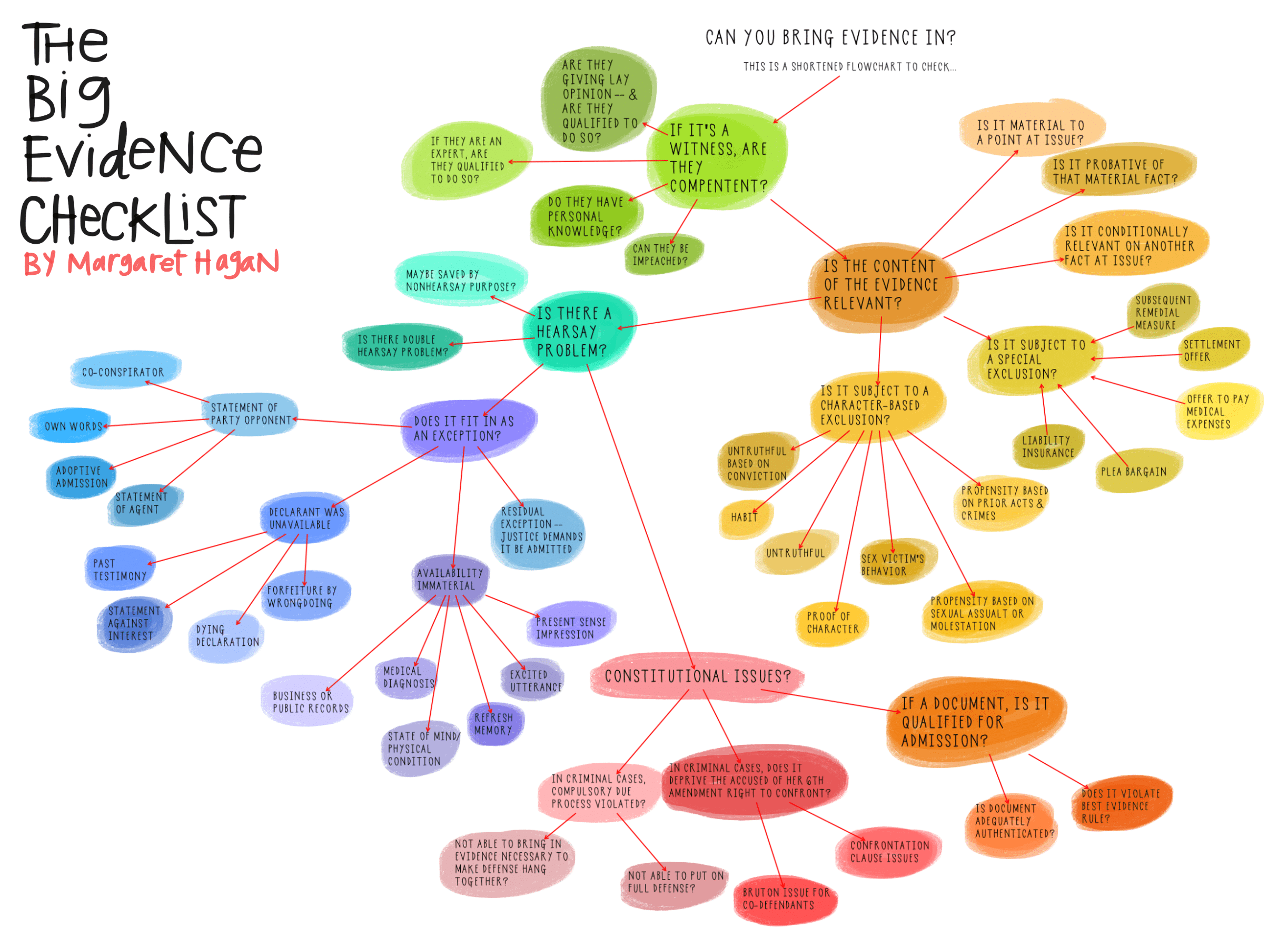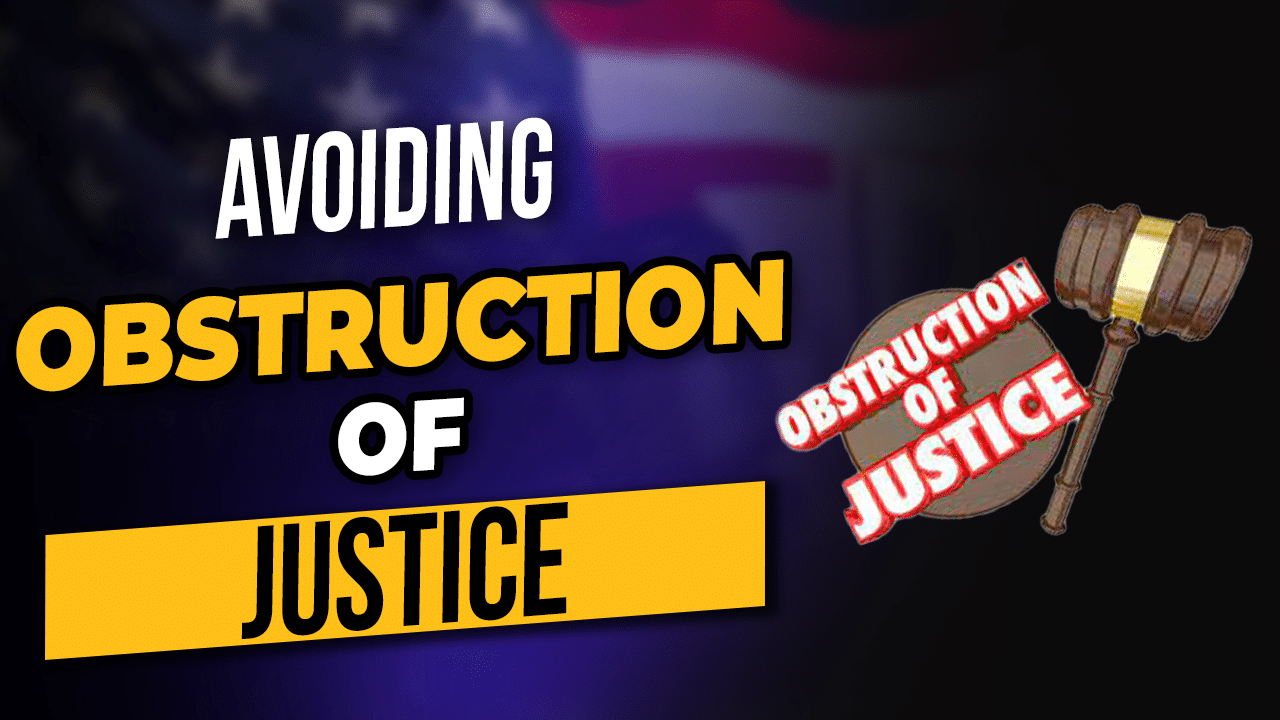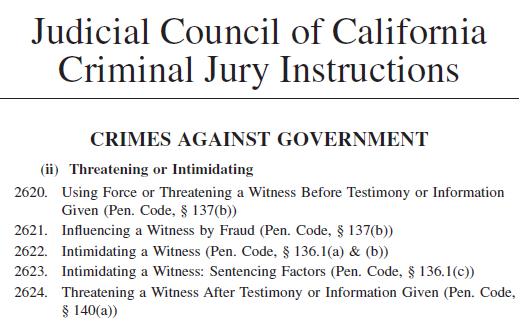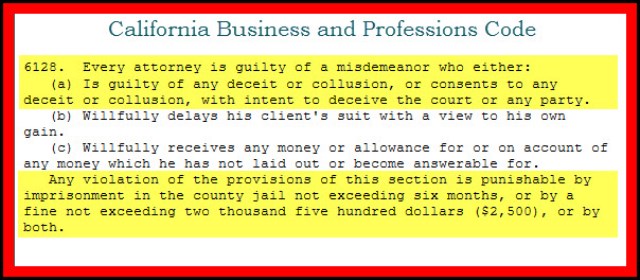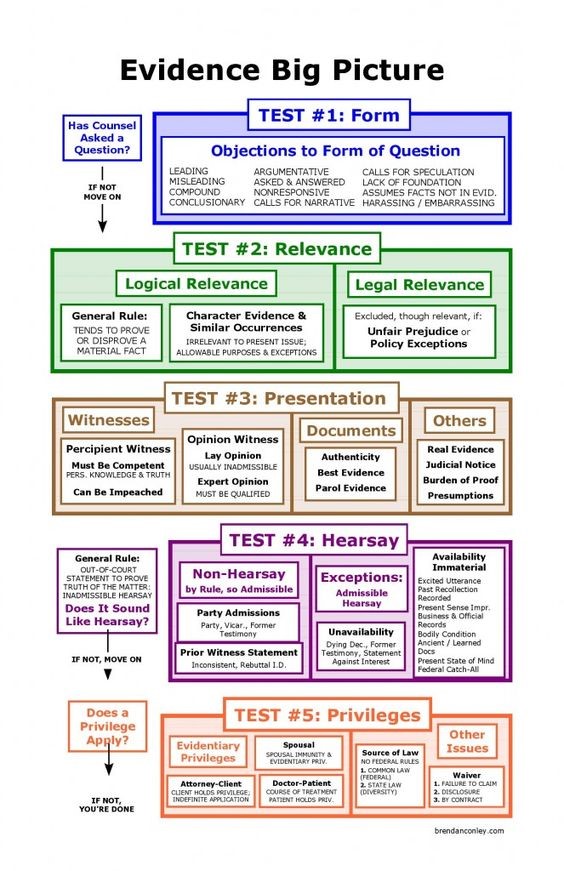What Is Considered Obstruction of Justice in California?
Under federal law, any act that “corruptly or by threats or force, or by any threatening letter or communication, influences, obstructs, or impedes, or endeavors to influence, obstruct, or impede, the due administration of justice” can be considered obstruction of justice. Obstruction of justice often involves the interference of a law enforcement investigation in which suspects attempt to conceal or destroy evidence, or they refuse to cooperative with law enforcement officers.
Although California law doesn’t contain specific statute for “obstruction of justice,” there are several types of misdemeanor and felony offenses that fall into the category of obstructing justice. The state’s legal system is designed to provide law enforcement with the ability to perform official duties without interference. This means if police believe your actions interfere with how they are operating in an official capacity, then you can be arrested for obstructing justice.
The following California Penal codes cover actions related to obstruction of justice:
- Penal Code 132 PC: It is illegal to offer false physical evidence you know is forged or fraudulent. Even if the evidence is partially true, if a single piece of it is known to be forged or fraudulent, it still violates this law and is considered obstruction of justice. This crime is a felony offense. If convicted, you can face a prison sentence between 16 months and three years and up to $10,000 in fines.
- Penal Code 134 PC: It is illegal for an individual to prepare false evidence with intent to use it fraudulently in a legal proceeding or investigation. If you break this law, you can be charged with a felony and face a jail sentence between 16 months and three years, as well as $10,000 in fines.
- Penal Code 135 PC: It is illegal to knowingly and willingly destroy, erase, or conceal any physical evidence that is in someone else’s possession. Deleting incriminating files from your computer hard drive during a criminal investigation is an example of an act that violates this law. If you are charged with destroying evidence, it is a misdemeanor that carries a penalty of up to six months in jail and a fine of $1,000.
- Penal Code 136.1 PC: It is illegal to tamper with, intimidate, prevent, or make an attempt to prevent a witness from giving their testimony at a legal proceeding. If the charge is treated as a misdemeanor, you can face up to one year in jail and $1,000 fine. If the charge is treated as a felony, you can face a two to four year jail sentence and up to $10,000 in fines.
- Penal Code 141 PC – Planting or Tampering with Evidence in California
- Penal Code 142 PC – Peace Officer Refusing to Arrest or Receive Person Charged with Criminal Offense
- Penal Code 182 PC – “Criminal Conspiracy” Laws & Penalties
- Penal Code 148 PC: It is illegal to intentionally resist, delay, or obstruct a law enforcement officer or EMT performing their official duties. This also includes obstructing an officer from interviewing a witness to a crime and interfering with police officers who attempting to arrest another person. This crime is a misdemeanor that is subject to a year in jail and up to $1,000 in fines.
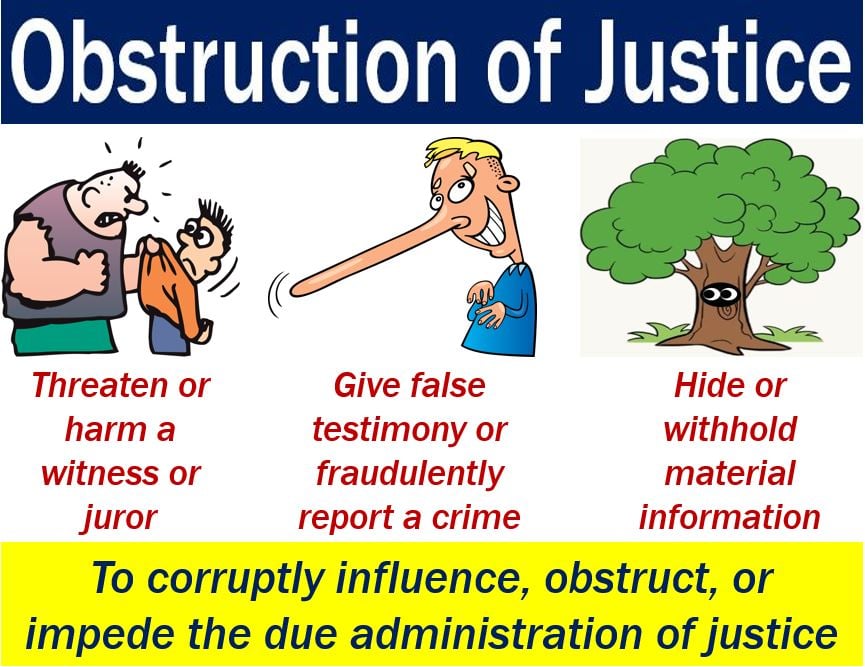
Obstruction of justice
Obstruction of justice refers to illegal actions that undermine a court case. For example, interfering with the administration or process of law, intimidating a juror, giving false testimony, or withholding material information. The term also includes intimidating or harming an officer of the law or a witness.
In the United States, obstruction of justice is a federal offense. It covers any attempt by an individual to corruptly ‘impede, obstruct, or influence’ the ‘due administration of justice.’
In the United Kingdom, people more commonly use the term ‘perverting the course of justice.’ It includes any act that prevents justice being served on the offender or any other party. In England and Wales, this ‘common law offense’ carries a maximum sentence of life imprisonment.
HG.org says that in the US, the penalties include fines and imprisonment of up to 20 years.
According to Legal-Dictionary.TheFreeDictionary.com, obstruction of justice is:
“A criminal offense that involves interference, through words or actions, with the proper operations of a court or officers of the court. The integrity of the judicial system depends on the participants’ acting honestly and without fear of reprisals.”
“Threatening a judge, trying to bribe a witness, or encouraging the destruction of evidence are examples of obstruction of justice. Federal and state laws make it a crime to obstruct justice.”
Obstruction of justice – specific intent
When somebody has a specific intent to interfere with or obstruct a judicial proceeding, they are probably guilty of obstruction of justice.
To convict somebody of this offense, simply having a specific intent to obstruct the proceeding is not enough. They must also know that a proceeding was pending at the time.
Additionally, there must be a nexus between the culprit’s attempt to obstruct justice and the proceeding.
The culprit (defendant) must also know about this nexus. A nexus is a connection or series of connections linking at least two things.
Obstruction of justice covers many people
The term may include crimes that elected officials, attorney generals, prosecutors, and judges commit.
It also includes fraudulently reporting a crime or providing false information to government agencies.
Once a criminal investigation starts, you face obstruction of justice charges if you threaten or interfere with witnesses. Hiding evidence or having improper conversations with a jury member are also offenses. source
Obstruction of Justice Crimes Alleged Against Family Court Temporary Judge and Sacramento County Bar Officer Paula Salinger
Whistleblower leaked records from a Sacramento Family Court case – embedded at the bottom of this post – indicate that criminal acts were committed by family law attorney and temporary judge Paula Salinger against an indigent, unrepresented, pro per family court party.
The pro per was a victim and witness in a family court criminal contempt case filed against a Salinger client, and the pro per also is disabled with a cognitive disability, and is a domestic violence victim, according to court records.
Family court reform advocates say the case is another example of the complete lack of oversight and accountability of attorneys who engage in egregious misconduct against disadvantaged, pro per litigants who can’t afford legal representation.
To continue reading, click Read more >> below:
 |
| Under California law, witness intimidation is punishable by maximum of three years in state prison. |
As Sacramento Family Court News previously reported, Salinger has been caught in several scandals including filing counterfeit documents in court, violating state laws and court rules, illegally attempting to obtain a final divorce judgment while an appeal in the same case was pending, and obtaining a questionable waiver of the requirements to become a temporary judge.
Salinger also obtained from controversial Judge Matthew Gary an illegal order for more than $10,000 in attorney fee sanctions against the same contempt and domestic violence victim. To benefit Salinger, Gary also illegally attempted to use fee waiver law to obstruct an appeal of several orders he issued for Salinger in the same case. Salinger’s firm, Woodruff, O’Hair, Posner & Salinger Inc., previously was sued for legal malpractice in a case alleging more than $1 million in damages.
Obstruction of Justice
The records indicate that Paula Salinger, a Sacramento County Superior Court sworn temporary judge and officer of the Sacramento Bar Association Family Law Executive Committee violated California Penal Code sections prohibiting witness intimidation and deceit of a witness. Under California law, both offenses are designated as obstruction of justice crimes. The circumstances also reveal new collusion between Salinger and Judge Matthew Gary.
As reflected by page one of the document set, at an unrelated court hearing held three weeks before the date calendared for the contempt case, in open court Gary disclosed to Salinger that he would deny the contempt claims, even though Salinger had yet to file a response to the contempt pleading. Gary’s prejudgment of the contempt matter was a clear violation of the California Code of Judicial Ethics, the state laws governing judge conduct.
The state Commission on Judicial Performance has publicly disciplined several judges for “acting in a way that manifested prejudgment…A trial judge should not prejudge the issues but should keep an open mind until all the evidence is presented to him.” In one CJP judicial discipline case, Judge Bruce Van Voorhis was disciplined for creating “the appearance of prejudgment in your discussion of the case in open court by improperly predicting the outcome of the case,” according to CJP records.
Click here for a compilation of CJP disciplinary decisions about prejudgment.
Salinger then used the judge’s unlawful disclosure in a threatening letter to the unrepresented opposing party:
“As the court indicated at the hearing on October 27, 2010, your Order to Show Case (sic) Re: Contempt does not contain sufficient factual basis to sustain the contempt. At the hearing on November 17, 2010, I intend to request the court dismiss the matter and order sanctions pursuant to Family Code section 271 for proceeding with the contempt…
…Should you provide written proof (a copy of a confirming letter to the court) by Monday, November 1, 2010 at 5:00 p.m. that the above matters have been dropped, I shall withdraw my requests for sanctions pursuant to FC § 271,” Salinger wrote in a letter to the contempt victim and witness.
Page one of the document set below is an authenticated copy of the threatening letter.
The alleged criminal acts were committed after the indigent, unrepresented pro per filed a criminal contempt of court allegation against a Salinger client. The contempt filing charged several violations of the Standard Family Law Restraining Orders, which are issued in all divorce proceedings.
SFLRO’s are automatically ordered against both parties when a dissolution of marriage is initiated in family court.
As page one of the document set reflects, Salinger illegally threatened the victim and witness with financial harm in the form of attorney fee sanctions if they did not drop the criminal contempt case.
As page three and four reflect, Salinger concurrently filed an illegal responsive declaration in the contempt case with a demand for $1,000 in attorney fee sanctions against the contempt victim and witness.
As the page two legal reference reflects, under California law the response to a contempt allegation may only be used to answer the contempt charge, or move to discharge the contempt on appropriate grounds. Requesting “affirmative relief,” including attorney fee sanctions, in response to a contempt allegation is prohibited by law. As page five of the document set shows, Salinger’s threat coerced the victim and witness to drop the contempt matter.
Witness Tampering Law
Family court reform advocates say the latest revelations are additional proof that the court operates effectively as a racketeering enterprise that deprives the public of the federally protected right to honest government services. Court watchdogs assert and have documented that judge pro tem attorneys receive kickbacks in the form of rubber-stamped orders and other preferential treatment from family court judges and employees.
The divorce lawyers who also hold the Office of Temporary Judge operate the family court settlement conference program in exchange for the kickbacks and emoluments, watchdogs charge. California Penal Code § 94 makes receipt of an emolument by a judicial officer a crime, and several federal criminal statutes prohibit similar conduct. The 2014 documentary film Divorce Corp designates Sacramento Family Court as the most corrupt in the United States. For our complete coverage of the movie, click here.
To Learn More…. Read MORE Below and click the links Below
Abuse & Neglect – The Mandated Reporters (Police, D.A & Medical & the Bad Actors)
Mandated Reporter Laws – Nurses, District Attorney’s, and Police should listen up
If You Would Like to Learn More About: The California Mandated Reporting LawClick Here
To Read the Penal Code § 11164-11166 – Child Abuse or Neglect Reporting Act – California Penal Code 11164-11166Article 2.5. (CANRA) Click Here
Mandated Reporter formMandated ReporterFORM SS 8572.pdf – The Child Abuse
ALL POLICE CHIEFS, SHERIFFS AND COUNTY WELFARE DEPARTMENTS INFO BULLETIN:
Click Here Officers and DA’s for (Procedure to Follow)
It Only Takes a Minute to Make a Difference in the Life of a Child learn more below
You can learn more here California Child Abuse and Neglect Reporting Law its a PDF file
Learn More About True Threats Here below….
We also have the The Brandenburg v. Ohio (1969) – 1st Amendment
CURRENT TEST = We also have the The ‘Brandenburg test’ for incitement to violence – 1st Amendment
We also have the The Incitement to Imminent Lawless Action Test– 1st Amendment
We also have the True Threats – Virginia v. Black is most comprehensive Supreme Court definition – 1st Amendment
We also have the Watts v. United States – True Threat Test – 1st Amendment
We also have the Clear and Present Danger Test – 1st Amendment
We also have the Gravity of the Evil Test – 1st Amendment
We also have the Elonis v. United States (2015) – Threats – 1st Amendment
Learn More About What is Obscene…. be careful about education it may enlighten you
We also have the Miller v. California – 3 Prong Obscenity Test (Miller Test) – 1st Amendment
We also have the Obscenity and Pornography – 1st Amendment
Learn More About Police, The Government Officials and You….
$$ Retaliatory Arrests and Prosecution $$
Anti-SLAPP Law in California
Freedom of Assembly – Peaceful Assembly – 1st Amendment Right
Supreme Court sets higher bar for prosecuting threats under First Amendment 2023 SCOTUS
We also have the Brayshaw v. City of Tallahassee – 1st Amendment – Posting Police Address
We also have the Publius v. Boyer-Vine –1st Amendment – Posting Police Address
We also have the Lozman v. City of Riviera Beach, Florida (2018) – 1st Amendment – Retaliatory Police Arrests
We also have the Nieves v. Bartlett (2019) – 1st Amendment – Retaliatory Police Arrests
We also have the Hartman v. Moore (2006) – 1st Amendment – Retaliatory Police Arrests
Retaliatory Prosecution Claims Against Government Officials – 1st Amendment
We also have the Reichle v. Howards (2012) – 1st Amendment – Retaliatory Police Arrests
Retaliatory Prosecution Claims Against Government Officials – 1st Amendment
Freedom of the Press – Flyers, Newspaper, Leaflets, Peaceful Assembly – 1$t Amendment – Learn More Here
Vermont’s Top Court Weighs: Are KKK Fliers – 1st Amendment Protected Speech
We also have the Insulting letters to politician’s home are constitutionally protected, unless they are ‘true threats’ – Letters to Politicians Homes – 1st Amendment
We also have the First Amendment Encyclopedia very comprehensive – 1st Amendment
Sanctions and Attorney Fee Recovery for Bad Actors
FAM § 3027.1 – Attorney’s Fees and Sanctions For False Child Abuse Allegations – Family Code 3027.1 – Click Here
FAM § 271 – Awarding Attorney Fees– Family Code 271 Family Court Sanction Click Here
Awarding Discovery Based Sanctions in Family Law Cases – Click Here
FAM § 2030 – Bringing Fairness & Fee Recovery – Click Here
Zamos v. Stroud – District Attorney Liable for Bad Faith Action – Click Here
Malicious Use of Vexatious Litigant – Vexatious Litigant Order Reversed
Mi$Conduct – Pro$ecutorial Mi$Conduct Prosecutor$
Attorney Rule$ of Engagement – Government (A.K.A. THE PRO$UCTOR) and Public/Private Attorney
What is a Fiduciary Duty; Breach of Fiduciary Duty
The Attorney’s Sworn Oath
Malicious Prosecution / Prosecutorial Misconduct – Know What it is!
New Supreme Court Ruling – makes it easier to sue police
Possible courses of action Prosecutorial Misconduct
Misconduct by Judges & Prosecutor – Rules of Professional Conduct
Functions and Duties of the Prosecutor – Prosecution Conduct
Standards on Prosecutorial Investigations – Prosecutorial Investigations
Information On Prosecutorial Discretion
Why Judges, District Attorneys or Attorneys Must Sometimes Recuse Themselves
Fighting Discovery Abuse in Litigation – Forensic & Investigative Accounting – Click Here
Criminal Motions § 1:9 – Motion for Recusal of Prosecutor
Pen. Code, § 1424 – Recusal of Prosecutor
Removing Corrupt Judges, Prosecutors, Jurors and other Individuals & Fake Evidence from Your Case
National District Attorneys Association puts out its standards
National Prosecution Standards – NDD can be found here
The Ethical Obligations of Prosecutors in Cases Involving Postconviction Claims of Innocence
ABA – Functions and Duties of the Prosecutor – Prosecution Conduct
Prosecutor’s Duty Duty to Disclose Exculpatory Evidence Fordham Law Review PDF
Chapter 14 Disclosure of Exculpatory and Impeachment Information PDF
Mi$Conduct – Judicial Mi$Conduct Judge$
Prosecution Of Judges For Corrupt Practice$
Code of Conduct for United States Judge$
Disqualification of a Judge for Prejudice
Judicial Immunity from Civil and Criminal Liability
Recusal of Judge – CCP § 170.1 – Removal a Judge – How to Remove a Judge
l292 Disqualification of Judicial Officer – C.C.P. 170.6 Form
How to File a Complaint Against a Judge in California?
Commission on Judicial Performance – Judge Complaint Online Form
Why Judges, District Attorneys or Attorneys Must Sometimes Recuse Themselves
Removing Corrupt Judges, Prosecutors, Jurors and other Individuals & Fake Evidence from Your Case
DUE PROCESS READS>>>>>>
Due Process vs Substantive Due Process learn more HERE
Understanding Due Process – This clause caused over 200 overturns in just DNA alone Click Here
Mathews v. Eldridge – Due Process – 5th, & 14th Amendment
Mathews Test – 3 Part Test– Amdt5.4.5.4.2 Mathews Test
“Unfriending” Evidence – 5th Amendment
At the Intersection of Technology and Law
We also have the Introducing TEXT & EMAIL Digital Evidence in California Courts – 1st Amendment
so if you are interested in learning about Introducing Digital Evidence in California State Courts
click here for SCOTUS rulings
Right to Travel freely – When the Government Obstructs Your Movement – 14th Amendment & 5th Amendment
What is Probable Cause? and.. How is Probable Cause Established?
Misuse of the Warrant System – California Penal Code § 170 – Crimes Against Public Justice – 4th, 5th, & 14th Amendment
What Is Traversing a Warrant (a Franks Motion)?
Dwayne Furlow v. Jon Belmar – Police Warrant – Immunity Fail – 4th, 5th, & 14th Amendment
Obstruction of Justice and Abuse of Process
What Is Considered Obstruction of Justice in California?
Penal Code 135 PC – Destroying or Concealing Evidence
Penal Code 141 PC – Planting or Tampering with Evidence in California
Penal Code 142 PC – Peace Officer Refusing to Arrest or Receive Person Charged with Criminal Offense
Penal Code 182 PC – “Criminal Conspiracy” Laws & Penalties
Penal Code 664 PC – “Attempted Crimes” in California
Penal Code 32 PC – Accessory After the Fact
Penal Code 31 PC – Aiding and Abetting Laws
What is Abuse of Process?
What is a Due Process Violation? – 4th Amendment & 14th Amendment
What’s the Difference between Abuse of Process, Malicious Prosecution and False Arrest?
Defeating Extortion and Abuse of Process in All Their Ugly Disguises
The Use and Abuse of Power by Prosecutors (Justice for All)
ARE PEOPLE LYING ON YOU?
CAN YOU PROVE IT? IF YES…. THEN YOU ARE IN LUCK!
Penal Code 118 PC – California Penalty of “Perjury” Law
Federal Perjury – Definition by Law
Penal Code 132 PC – Offering False Evidence
Penal Code 134 PC – Preparing False Evidence
Penal Code 118.1 PC – Police Officer$ Filing False Report$
Spencer v. Peters– Police Fabrication of Evidence – 14th Amendment
Penal Code 148.5 PC – Making a False Police Report in California
Penal Code 115 PC – Filing a False Document in California
Misconduct by Government Know Your Rights Click Here
Under 42 U.S.C. $ection 1983 – Recoverable Damage$
42 U.S. Code § 1983 – Civil Action for Deprivation of Right$
18 U.S. Code § 242 – Deprivation of Right$ Under Color of Law
18 U.S. Code § 241 – Conspiracy against Right$
Section 1983 Lawsuit – How to Bring a Civil Rights Claim
Suing for Misconduct – Know More of Your Right$
Police Misconduct in California – How to Bring a Lawsuit
How to File a complaint of Police Misconduct? (Tort Claim Forms here as well)
Deprivation of Rights – Under Color of the Law
What is Sua Sponte and How is it Used in a California Court?
Removing Corrupt Judges, Prosecutors, Jurors
and other Individuals & Fake Evidence from Your Case
Anti-SLAPP Law in California
Freedom of Assembly – Peaceful Assembly – 1st Amendment Right
How to Recover “Punitive Damages” in a California Personal Injury Case
Pro Se Forms and Forms Information(Tort Claim Forms here as well)
What is Tort?
Tort Claims Form
File Government Claim for Eligible Compensation
Complete and submit the Government Claim Form, including the required $25 filing fee or Fee Waiver Request, and supporting documents, to the GCP.
See Information Guides and Resources below for more information.
Tort Claims – Claim for Damage, Injury, or Death (see below)
Federal – Federal SF-95 Tort Claim Form Tort Claim online here or download it here or here from us
California – California Tort Claims Act – California Tort Claim Form Here or here from us
Complaint for Violation of Civil Rights (Non-Prisoner Complaint) and also UNITED STATES DISTRICT COURT PDF
Taken from the UNITED STATES DISTRICT COURT FOR THE EASTERN DISTRICT OF CALIFORNIA Forms source
WRITS and WRIT Types in the United States
How do I submit a request for information?
To submit a request send the request via mail, fax, or email to the agency. Some agencies list specific departments or people whose job it is to respond to PRA requests, so check their websites or call them for further info. Always keep a copy of your request so that you can show what you submitted and when.
from the ACLU we have 2 types of SB 1421 Templates for Sample Requests
1. Incident Based Request: Use this template if you want records related to a particular incident, like the investigative record for a specific police shooting, an arrest where you believe an officer may have been found to have filed a false report, or to find out whether complaint that an officer committed sexual assault was sustained.
ACLU Download Word document | ACLU Download PDF
or from us Download Word document | or from us Download PDF
2. Officer Based Request: Use this template if you want to find any public records of misconduct related to a particular officer or if he or she has been involved in past serious uses of force.
ACLU Download Word document | ACLU Download PDF
or from us Download Word document | or from us Download PDF
We also have more robust sample letters below:
Sample Letter | SB 1421 & SB 16 Records
Download Word document | Download PDF
Sample Letter | Police Recordings
Download Word document | Download PDF
The CPRA is now located at Government Code sections 7920.000-7931.000
The First Amendment Coalition also has some useful information to help explain the PRA process.
Appealing/Contesting Case/Order/Judgment/Charge/ Suppressing Evidence
First Things First: What Can Be Appealed and What it Takes to Get Started – Click Here
Options to Appealing– Fighting A Judgment Without Filing An Appeal Settlement Or Mediation
Cal. Code Civ. Proc. § 1008 Motion to Reconsider
Penal Code 1385 – Dismissal of the Action for Want of Prosecution or Otherwise
Penal Code 1538.5 – Motion To Suppress Evidence in a California Criminal Case
CACI No. 1501 – Wrongful Use of Civil Proceedings
Penal Code “995 Motions” in California – Motion to Dismiss
WIC § 700.1 – If Court Grants Motion to Suppress as Evidence
Suppression Of Exculpatory Evidence / Presentation Of False Or Misleading Evidence – Click Here
Notice of Appeal — Felony (Defendant) (CR-120) 1237, 1237.5, 1538.5(m) – Click Here
California Motions in Limine – What is a Motion in Limine?
Petition for a Writ of Mandate or Writ of Mandamus (learn more…)
PC 1385 – Dismissal of the Action for Want of Prosecution or Otherwise
Retrieving Evidence / Internal Investigation Case
Conviction Integrity Unit (“CIU”) of the Orange County District Attorney OCDA – Click Here
Fighting Discovery Abuse in Litigation – Forensic & Investigative Accounting – Click Here
Orange County / LA County Data, BodyCam, Police Report, Incident Reports,
and all other available known requests for data below:
SEARCH SB-1421 SB-16 Incidents of LA County, Oakland
California Senate Bill 16 (SB 16) – 2023-2024 – Peace officers: Release of Records
APPLICATION TO EXAMINE LOCAL ARREST RECORD UNDER CPC 13321 Click Here
Learn About Policy 814: Discovery Requests OCDA Office – Click Here
Request for Proof In-Custody Form Click Here
Request for Clearance Letter Form Click Here
Application to Obtain Copy of State Summary of Criminal HistoryForm Click Here
Request Authorization Form Release of Case Information – Click Here
Texts / Emails AS EVIDENCE: Authenticating Texts for California Courts
Can I Use Text Messages in My California Divorce?
Two-Steps And Voila: How To Authenticate Text Messages
How Your Texts Can Be Used As Evidence?
California Supreme Court Rules:
Text Messages Sent on Private Government Employees Lines
Subject to Open Records Requests
case law: City of San Jose v. Superior Court – Releasing Private Text/Phone Records of Government Employees
Public Records Practices After the San Jose Decision
The Decision Briefing Merits After the San Jose Decision
Rules of Admissibility – Evidence Admissibility
Confrontation Clause – Sixth Amendment
Exceptions To The Hearsay Rule – Confronting Evidence
Prosecutor’s Obligation to Disclose Exculpatory Evidence
Successful Brady/Napue Cases – Suppression of Evidence
Cases Remanded or Hearing Granted Based on Brady/Napue Claims
Unsuccessful But Instructive Brady/Napue Cases
ABA – Functions and Duties of the Prosecutor – Prosecution Conduct
Frivolous, Meritless or Malicious Prosecution – fiduciary duty
Section 832.7 – Peace officer or custodial officer personnel records
Senate Bill No. 1421 – California Public Records Act
Assembly Bill 748 Makes Video Evidence Captured by Police Agencies Subject to Disclosure as Public Records
SB 2, Creating Police Decertification Process and Expanding Civil Liability Exposure
The Right To Know: How To Fulfill The Public’s Right Of Access To Police Records
How Access to California Police Records
Los Angeles County Sheriff’s Department SB-1421 Records
SB1421 – Form Access to California Police Records
California Statewide CPRA Requests Submit a CPRA Request
Electronic Audio Recording Request of OC Court Hearings
CPRA Public Records Act Data Request – Click Here
Here is the Public Records Service Act Portal for all of CALIFORNIA Click Here
Police BodyCam Footage Release
Cleaning Up Your Record
Tossing Out an Inferior Judgement – When the Judge Steps on Due Process – California Constitution Article VI – Judicial Section 13
Penal Code 851.8 PC – Certificate of Factual Innocence in California
Petition to Seal and Destroy Adult Arrest Records – Download the PC 851.8 BCIA 8270 Form Here
SB 393: The Consumer Arrest Record Equity Act – 851.87 – 851.92 & 1000.4 – 11105 – CARE ACT
Expungement California – How to Clear Criminal Records Under Penal Code 1203.4 PC
How to Vacate a Criminal Conviction in California – Penal Code 1473.7 PC
Seal & Destroy a Criminal Record
Cleaning Up Your Criminal Record in California (focus OC County)
Governor Pardons –What Does A Governor’s Pardon Do
How to Get a Sentence Commuted (Executive Clemency) in California
How to Reduce a Felony to a Misdemeanor – Penal Code 17b PC Motion
PARENT CASE LAW
RELATIONSHIP WITH YOUR CHILDREN &
YOUR CONSTITUIONAL RIGHT$ + RULING$
YOU CANNOT GET BACK TIME BUT YOU CAN HIT THOSE IMMORAL NON CIVIC MINDED PUNKS WHERE THEY WILL FEEL YOU = THEIR BANK
Family Law Appeal – Learn about appealing a Family Court Decision Here
9.3 Section 1983 Claim Against Defendant as (Individuals) — 14th Amendment this CODE PROTECT$ all US CITIZEN$
Amdt5.4.5.6.2 – Parental and Children’s Rights“> – 5th Amendment this CODE PROTECT$ all US CITIZEN$
9.32 – Interference with Parent / Child Relationship – 14th Amendment this CODE PROTECT$ all US CITIZEN$
California Civil Code Section 52.1
Interference with exercise or enjoyment of individual rights
Parent’s Rights & Children’s Bill of Rights
SCOTUS RULINGS FOR YOUR PARENT RIGHTS
SEARCH of our site for all articles relating for PARENTS RIGHTS Help!
Child’s Best Interest in Custody Cases
Are You From Out of State (California)? FL-105 GC-120(A)
Declaration Under Uniform Child Custody Jurisdiction and Enforcement Act (UCCJEA)
Learn More:Family Law Appeal
Necessity Defense in Criminal Cases
Can You Transfer Your Case to Another County or State With Family Law? – Challenges to Jurisdiction
Venue in Family Law Proceedings
GRANDPARENT CASE LAW
Do Grandparents Have Visitation Rights? If there is an Established Relationship then Yes
Third “PRESUMED PARENT” Family Code 7612(C) – Requires Established Relationship Required
Cal State Bar PDF to read about Three Parent Law –
The State Bar of California family law news issue4 2017 vol. 39, no. 4.pdf
Distinguishing Request for Custody from Request for Visitation
Troxel v. Granville, 530 U.S. 57 (2000) – Grandparents – 14th Amendment
S.F. Human Servs. Agency v. Christine C. (In re Caden C.)
9.32 Particular Rights – Fourteenth Amendment – Interference with Parent / Child Relationship
Child’s Best Interest in Custody Cases
When is a Joinder in a Family Law Case Appropriate? – Reason for Joinder
Joinder In Family Law Cases – CRC Rule 5.24
GrandParents Rights To Visit
Family Law Packet OC Resource Center
Family Law Packet SB Resource Center
Motion to vacate an adverse judgment
Mandatory Joinder vs Permissive Joinder – Compulsory vs Dismissive Joinder
When is a Joinder in a Family Law Case Appropriate?
Kyle O. v. Donald R. (2000) 85 Cal.App.4th 848
Punsly v. Ho (2001) 87 Cal.App.4th 1099
Zauseta v. Zauseta (2002) 102 Cal.App.4th 1242
S.F. Human Servs. Agency v. Christine C. (In re Caden C.)
Family Treatment Court Best Practice Standards
Download Here this Recommended Citation
 Epic Criminal / Civil Right$ SCOTUS Help – Click Here
Epic Criminal / Civil Right$ SCOTUS Help – Click Here
 Epic Parents SCOTUS Ruling – Parental Right$ Help – Click Here
Epic Parents SCOTUS Ruling – Parental Right$ Help – Click Here
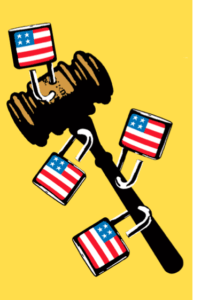 Judge’s & Prosecutor’s Jurisdiction– SCOTUS RULINGS on
Judge’s & Prosecutor’s Jurisdiction– SCOTUS RULINGS on
 Prosecutional Misconduct – SCOTUS Rulings re: Prosecutors
Prosecutional Misconduct – SCOTUS Rulings re: Prosecutors
Please take time to learn new UPCOMING
The PROPOSED Parental Rights Amendment
to the US CONSTITUTION Click Here to visit their site
The proposed Parental Rights Amendment will specifically add parental rights in the text of the U.S. Constitution, protecting these rights for both current and future generations.
The Parental Rights Amendment is currently in the U.S. Senate, and is being introduced in the U.S. House.
